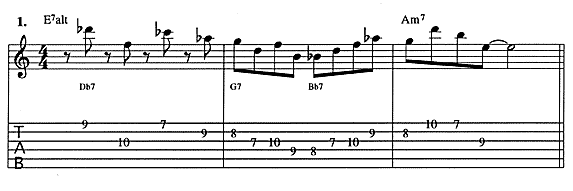Diminished Capacities (and Stupid Guitar Tricks!)
When it's time to play over altered dominant chords, the half/whole diminished scale often comes in handy! (To save time and typing, from now on I'll be referring to the half/whole diminished scale by just saying "diminished scale".) In addition to the root, third, fifth and seventh of the dominant chord, this scale also has the b9, #9 and b5. This makes it ideal for the following chords: 7b9, 7#9, 13b9, 13#9, or any combination of those with a b5 or #11.

A question that pops up a lot in my studio is "How do I use diminished scales without sounding like an exercise book?" Well, my suggestion for the diminished scale is to treat it like any other scale and look at the harmony contained within the scale! Obviously, there are diminished chords within the diminished scale (duh), but those chords, like the diminished scale itself, are so symmetrical that they leave us fighting the "pattern" sound if we try to use them as material for lines.
If we look a little harder at the scale (and are willing to use creative spelling on occasion), we see that the diminished scale contains four dominant seventh chords. (It has a lot more harmony in it, but let's stop there for now!)

The dominant seventh chords in the diminished scale have roots a minor third apart. For an E diminished scale, that'd be E7, G7, Bb7 and Db7. These four chords together contain all the tones of the E diminished scale, so by using just the chord tones of these four chords, lines could be built which would be based on diminished harmony without the sound of just "running the scale".
I've included a couple of examples (see 1 and 2). In each example, I'm using the diminished material over E7 altered dominant chords in the first two bars and resolving them in the last bar to A minor. (Example 2 uses the chord-tone stuff in bar one, grafted to a more common "pattern" in bar two. The pattern happened as a result of my thinking about the root and 7th of each chord, so I don't feel too bad about it.) The first two bars of each example would also work over G7, Bb7 or Db7 chords; try that and come up with your own ways to resolve the lines to Cm, Ebm or Gbm tonic chords.
Play Example 1


Play Example 2
Stupid Guitar Trick:
Diminished chords are built in minor thirds. Minor thirds invert to major sixths. There are two pairs of strings on the guitar that are tuned in major sixths: the 1st and 3rd strings (E-G) and the 2nd and 4th strings (B-D). You can exploit the tuning to come up with some cheap and easy diminished lines! Any diminished scale fragment you play on string 3 could be repeated on string 1 at the same fret; it'd just have the effect of sequencing your original idea up a major 6th. Likewise, a scale fragment played on string 4 could be repeated on string 2. I've written out a pair of examples (see 3 and 4); try them out and I think you'll quickly hear what I mean. Amuse yourself for awhile - but keep in mind that if you do this too much in a solo, you'll start to hear that "jazz student playing patterns" sound.
Play Example 3


Play Example 4
Food for thought: the guitar also has two pairs of strings that are tuned to minor sevenths. Minor sevenths invert to major seconds. Hmmm - what could be done with a bunch of major seconds? (I enjoy puzzles like this, but then again, I enjoy the smell of Volkswagen exhaust. That is, classic VW exhaust, not the new stuff. There's a difference.)